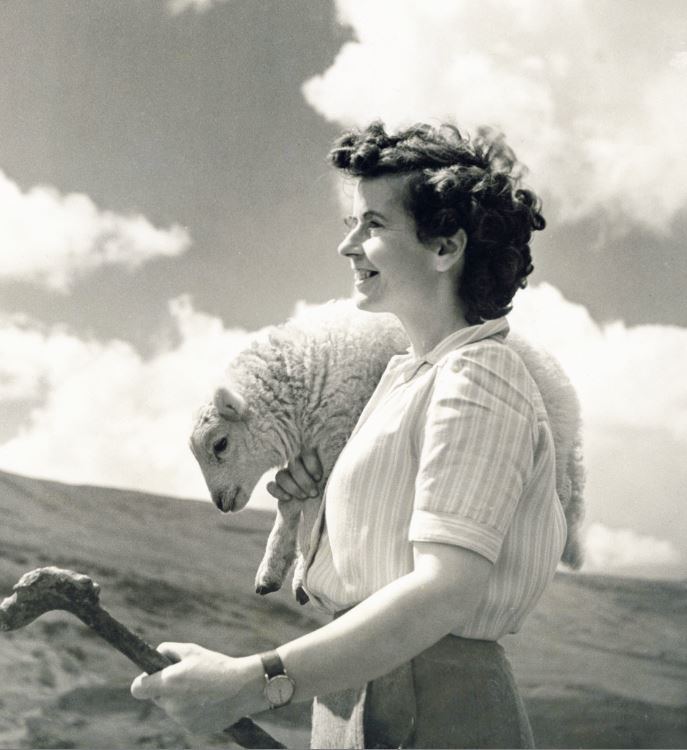Win or bust – Returning the red squirrel to Snowdonia
3 January 2019
One woman’s passion for the wilds of North Wales has ignited a resurgence of the charismatic red squirrel. Ecologist Dr Craig Shuttleworth tells us more about the return of red squirrels and their friends the pine martens to Snowdonia National Park.
Esmé Kirby is synonymous with Snowdonia and was immortalised in the best selling book ‘I bought a Mountain’. Her passion for wild places drove her to fight despoilment and ultimately to establish the Snowdonia Society. ‘Win or bust’ was her approach to every campaign, lightening manoeuvres, out of the blocks at the gun, dogged and indomitable. Her successes were impressive. Her presence was sometimes divisive and eventually this contributed to her departure from the Society.

Esmé Kirby, guardian of Snowdonia. Recreated with permission of Y Lolfa publishers.
Her next venture, the Esmé Kirby Snowdonia Trust, heralded no less of a single minded approach to landscape protection. In 1996, and at the age of 85, she announced the ambition was to ‘Make Anglesey, once again, red squirrel country’. The Trustees embraced this with enthusiasm and bureaucratic obstacles were swept aside.
In the mid 1990s, there had been over 3,500 grey squirrels resident across the 720km2 island. The red squirrel population in contrast had been close to extinction with only around 40 animals remaining and facing the duel threats posed by their invasive cousins.
Grey squirrels out compete red squirrels for resources and also carry the squirrelpox virus, an infection which does not harm them but which is lethal to native red squirrels. Eradication proved challenging, whilst a series of red squirrel releases to boost numbers was deemed controversial by some in the scientific community who castigated it as cavalier and against national policy.
While Esme sadly passed away in 1999. Her mission lived on and in 2013 her vision was achieved and the last island grey squirrel was removed.
It is of course the victors who get to write the history books and thus I am pleased to write that the 700 adult red squirrels in Anglesey represent the largest and most genetically diverse population in Wales. These red squirrels are not confined to the deep dark coniferous woodlands as many conservation text books would have you believe. Instead they are found in broadleaved woodland, hedgerows, parks and suburban gardens, in fact anywhere there is even a modest woodland cover there are now red squirrels. Their recovery has been spectacular and local people have taken them into their hearts as their social media posts are testament.

The beautiful but endangered red squirrel has returned to parks & gardens across Anglesey . Photo credit: Alan Jones Photography.
In the winter of 2009/10 something quite unexpected was to happen in north Wales. As if drawn towards the mountains where the plans for their conservation were first hatched, red squirrels started to cross the Menai Strait and spread inland. A natural re-colonisation of Gwynedd and the National Park had begun. A population became established in the coastal woodlands in and around the City of Bangor and then the first animals ventured into Snowdonia. There quickly followed sightings of animals within woodland near Llanberis at the foot of Snowdon, and at Rhyd Ddu & Beddgelert to the delight of the Snowdonia National Park Authority because elsewhere red squirrel sightings were incredibly rare.
Red squirrels also started to move up into the Ogwen valley. In 2016, eight red squirrels were released into coniferous plantation woodland at the top of the valley just inside the National Park boundary. The animals were obtained from Zoological collections including the Welsh Mountain Zoo. They were housed for a few weeks in forest enclosures before being released, Since then the population has flourished and red squirrels now a regular sight in many gardens in the northern part of Bethesda.
Having successfully turned Anglesey from grey to red, work is well underway to do the same in northern Gwynedd with increased grey squirrel control involving the recruitment of local volunteers to undertake culling and also to monitor red and grey squirrels using wildlife cameras. Community support for grey squirrel control is strong as local people can see the Anglesey success close by and understand the ecological and green-tourism benefits that the red squirrel restoration delivered.

Pine martens spotted on a squirrel feeder in North Wales. Photo credit: Clocaenog red squirrel project.
In 2019, we also aim to release pine martens in the Bangor area with the anticipation that they will help reduce grey squirrel numbers as observed in Scotland and Ireland. The project aims to release 20 captive bred animals in a pioneering initiative with the Wildwood Trust, New Forest Wildlife Park, Zoological Society of Wales, Animals Plant & Health Agency, International Zoo Veterinary Group, Bangor University and Newcastle University (Australia). It’s a daring step, in many respects a gamble, but fortune has favoured us before.
Dr Craig Shuttleworth
free lance ecologist involved in the Red Squirrels United project EU LIFE14 NAT/UK/000467
